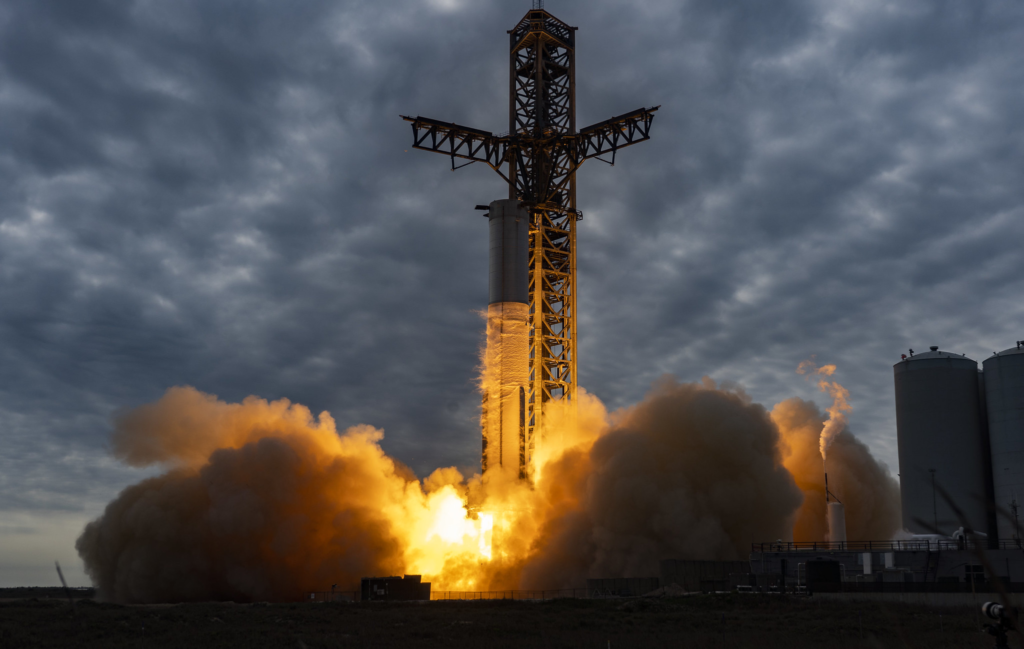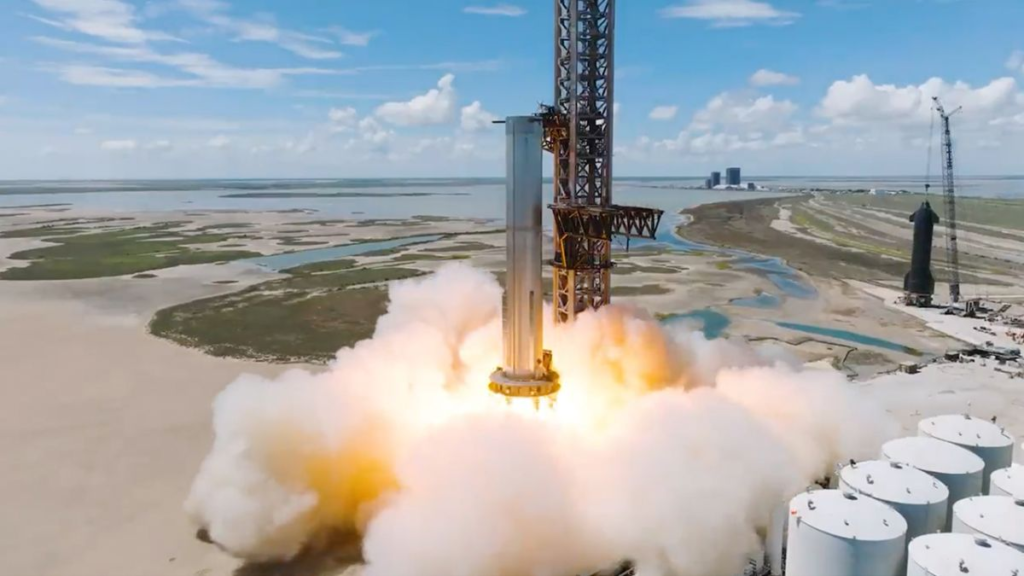
How Water Could Help Prevent Starship Pad Destruction
For many years now water deluge systems have been common across the majority of launch sites around the globe. In most cases, they act as a sound suppression system to absorb or deflect acoustic energy generated during a rocket launch. In SpaceX’s case, however, the primary application is a bit different than what you typically see.
Just days ago we saw some of the initial testing of the new steel plate and water deluge system installed under the orbital launch mount. Here you could see thousands of gallons of water rushing out and flying between the legs of the mount. With the maiden flight causing a decent bit of damage to this exact area, SpaceX believes this new system is overkill and should withstand the force of 33 Raptor engines.
In the past, there have been a few examples of rockets causing significant damage to the pad, and the addition of water helping solve it. Here I will go more in-depth into the recent testing, the benefits of a water deluge system, the upcoming static fires tests, and more.
Water Cooled Flame Deflector

After Starship’s first launch left the pad with quite a crater and sent debris flying in every direction, SpaceX knew that the next attempt would need proper pad protection. Even before the launch they knew this and had already been working on a water cooled flame deflector. Due to reasons such as the high water table in Boca Chica, time, money, etc., they decided to not build a massive trench and instead work right under the orbital launch mount.
During a rocket launch, as engine exhaust gasses exceed the speed of sound, they collide with the ambient air and shockwaves are created, with noise levels approaching 200 db. This energy can be reflected by the launch platform and pad surfaces, and could potentially cause damage to the launch vehicle, payload, and crew. For instance, the maximum admissible overall sound power level (OASPL) for payload integrity is approximately 145 db. Thankfully, there is a solution, in that sound is dissipated by huge volumes of water distributed across the launch pad and launch platform during liftoff. While important in Starship’s case, one of the biggest driving factors for the addition of water to the steel plate is to keep it cool.
In regard to this, Dr. Phil Metzger, a planetary scientist with quite a lot of experience, gave some insight into this process and how it could work. He commented that he used steel plates for some of the Morpheus launch locations so that they weren’t tied down to places with concrete. He analyzed the heating of the sheet and showed that the heat would redistribute fast enough that it would not locally melt on the surface, and that the steel plate was large enough to take the heat of the entire launch event without melting.
In reference to using this method for Starship, he was quoted saying, “For such a large rocket that much steel would be excessive. And ablative would not be enough to solve this, either. He continued by saying, “But he said it will be water-cooled, which is an awesome idea. The water will be taking heat out of the steel in realtime so it won’t melt. Simple, and it should be effective.” This would also allow SpaceX to use much less steel as it won’t be needed to distribute the heat.
With 33 Raptor engines that close to the ground, the forces and heat are immense to the point where SpaceX can’t just rely on the steel itself to keep everything under control. What will be very interesting to see is the upcoming static fire test of Super Heavy. This will not only test the upgraded booster but the new pad protection system in full. In the past we saw single Raptor engines tests on small squares of mock steel plate. While they performed well, a 33-engine static fire will be the real test. Its important to point out however that the results of this upcoming test don’t necessarily mean the pad will perform the same during launch day.
This exact scenario occurred on the first integrated test flight. SpaceX completed a 33-engine static fire on the Fondag concrete which held up for the most part. Then on launch day, the results were very different. That’s because it was a partial thrust static fire which will likely be the case again when Booster 9 lights its engines. This being said, it will still give a lot of valuable data and inform the company on what to do next.
Water Deluge

Data from the first Space Shuttle launch found an overpressure wave created by the shuttle’s three RS-25 engines and the four-segment solid rocket boosters contributed to the loss of sixteen and damage to an additional 148 thermal protection tiles prompting modifications to the Sound Suppression Water System (SSWS) installed at both launch pads at Kennedy Space Center’s Launch Complex 39.
The resulting gravity fed system, used through the remainder of the program, began release from a 300,000-US-gallon (1.1-million-litre) water tower at the launch site 6.6 seconds before main engine start through 7 feet (2.1 m) diameter pipes connected to the mobile launch platform. Water flowed out six 12-foot-high (3.7 m) towers known as “rainbirds” onto the launch platform and flame trench below, emptying the system in 41 seconds with a peak flow of reducing acoustic energy levels to approximately 142 dB. The massive white clouds that billowed around the shuttle at each launch were not smoke, but wet steam generated as the rocket exhaust boiled away huge quantities of water. Something we will likely see on future Starship launches.
Even when the Space Launch System (SLS) rocket lifts off, its four RS-25 engines and two solid rocket boosters will produce a combined 8.4 million pounds of thrust, and with that comes a torrent of heat and noise. To help protect the SLS rocket, Orion spacecraft, Mobile Launcher, and launch pad from the extreme acoustic and temperature environment, water sprays onto the launch pad during ignition and liftoff. During a water deluge test, thousands of gallons of water flowed into the flame trench and through upgraded systems at NASA Kennedy Space Center’s Launch Pad 39B.
The test was a milestone for Exploration Ground Systems to confirm and baseline the performance of the pad’s Ignition Overpressure and Sound Suppression (IOP/SS) systems, including new portions of the system that were upgraded after the Space Shuttle Program. The IOP/SS systems reduce the effects of acoustic energy and main engine ignition at liftoff, and reduces sound pressure levels experienced by the vehicle during ascent.
The test included a preliminary phase to flow about 150,000 gallons of water at high speed from a holding tank through all of the new and modified piping and valves at the flame trench, through the nozzles at the top of the flame deflector and mobile launcher interface pipes at the pad. On the second day, approximately 450,000 gallons of water flowed through the systems.
After the launch of SLS, NASA did an assessment of the pad infrastructure. “The exploration ground systems exceeded our expectation for its overall performance,” Artemis mission manager, Mike Sarafin said during a Nov. 21 news briefing following Orion’s closest lunar flyby. “We did have a little bit of damage on the mobile launcher, but it will be ready to support Artemis II and we had accounted for that previously in our pre-plan and our budget for the time between Artemis I and II” he said.
The assessment enabled teams to inspect areas on the mobile launcher and identify specific damage and debris around the pad. Engineers identified minor damage to umbilicals and the crew access arm on the mobile launcher. Damage to the pneumatic lines associated with gaseous nitrogen and gaseous helium caused the oxygen sensors on the pad to show there were low oxygen readings due to leaks, which teams have since isolated. The most significant issue is the damage to the elevators, which required the team to use the stairs for inspections on the 355-foot-tall tower structure, which has 662 steps, and extended the time required for the inspection. The elevators will remain out of service for several months to complete repairs. As for the deflector and steel plates, they held up as intended despite the immense amount of heat and force.
The sound and heat from Starship are not easy factors to deal with. NASA has been trying various methods for many years on less powerful rockets with varying success. The thrust expended during lift-off of SLS would cause quite a bit of damage if it wasn’t for modifications made to Launch Pad 39B. In that case, the new main flame deflector was critical to safely deflecting the plume exhaust from the massive rocket during launch. Measuring approximately 57 feet wide, 43 feet high and 70 feet long, the deflector’s north side is slanted at about a 58-degree angle and will divert the rocket’s exhaust, pressure and intense heat to the north at liftoff. “The thick steel plates are designed to withstand the exhaust and heat from several launches,” said Nick Moss, EGS pad deputy project manager. “There is flexibility of maintenance; as steel plates closest to the exhaust plume begin to erode, they can be replaced” he said.
It will be interesting to see how well SpaceX’s steel plate system works and how many launches it can withstand before repairs or at least maintenance work is necessary. Assuming it does its job, after each launch the company will take a look at how it held up and whether or not it’s ready for the next launch.
Conclusion
SpaceX just completed the first test of the water cooled flame deflector under the orbital launch mount. This system is very important in order to protect both the pad and the rocket itself from debris and sound. We will have to wait and see how it progresses and the impact it has on the space industry.